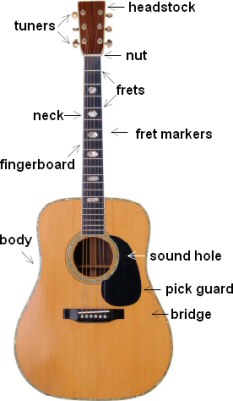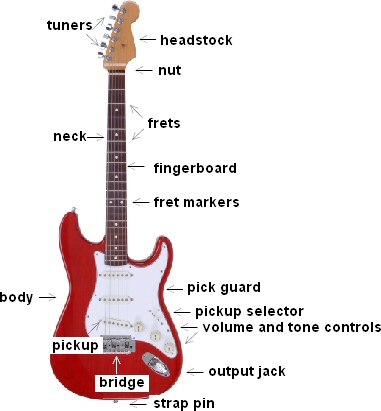The Parts of a Guitar
Knowing the parts of the guitar is important. You need to be familiar with what each part does and how to use them.
Parts of Acoustic and Electric Guitars
Acoustic and electric guitars have many parts in commmon, but they do differ in some important areas. The images below show the parts on both types of guitar.


The Headstock
The headstock is found at the end of the neck. Its primary function is to hold the tuning machines. It is also where you usually find the logo of the guitar manufacturer. Some guitars may not have a headstock (guitars made by Steinberger for example).
Tuning Machines
Tuning machines (also known as tuners, tuning pegs, or tuning keys) are used to tune the guitar. Strings are threaded through holes in the tuning machines and wrapped around a post by turning the tuning pegs. The strings can be adjusted higher or lower in pitch by twisting the tuning pegs.
The Nut
The nut is located where the neck and headstock meet. There are grooves for each of the strings to pass through. The nut may be made from a variety of materials, including plastic, metal, bone, and more. Some guitars have a locking nut to help keep the guitar in tune.
The Neck
The neck is the part of the guitar where you play notes and chords by pressing the strings down against the frets. It contains the fingerboard, frets, and possibly fret markers. Necks come in a variety of shapes and sizes.
The Fingerboard
The fingerboard or fretboard is the top part of the neck. It may be a separate piece of wood, usually rosewood, or the neck and fingerboard may be one piece of wood, often made of maple.
Inlays and Fret Markers
A fret marker is generally a circular piece of plastic or other material that is placed in the fingerboard between the frets. This makes finding a particular fret easier. Classical guitars may not have these markers or may move them to the top of the fingerboard. Some guitars may have more elaborate fret markers, such as a skull or other design.
Fret markers are generally placed at the third, fifth, seventh, ninth, twelfth, fifteenth, seventeenth, nineteenth, twenty-first, and twenty-fourth frets. You may also see a fret marker on the first fret on some guitars. The markers at the twelfth and twenty-fourth frets will often be different to allow quick identification of these frets. For example, if the fret markers are dots, one dot would be used for most frets, but there would be two dots on the twelfth and twenty-fourth frets. However, the specific arrangement of fret markers will depend on the type of guitar and the number of frets it has.
An inlay is similar to a fret marker, but is a more elaborate design. The designs may cover the entire fretboard, such as the vine inlay on the Ibanez Jem. Some inlays may perform double duty as fret markers, but others may not.
Frets
A fret is a strip of metal that is embedded in the neck at specific intervals to allow different pitches to be produced along the guitar neck. The number of frets will vary depending on the type of guitar.
The Body
The body of the guitar performs several functions:
- 1. It aids in sound production.
- 2. It holds the bridge, electronics (pickups, jack, knobs, and switches), and pick guard.
- 3. Secures the neck in place.
The body of a guitar can be made from a variety of materials including various woods, graphite, and more.
The Bridge
The bridge is responsible for holding the strings and determining the action of the strings (the height of the strings in relation to the neck of the guitar). There are several common types of bridges:
- 1. Classical style: strings are threaded through a hole and 'tied' around bridge.
- 2. Floyd Rose: strings are held in place by a small block that is tightened by turning a screw with an Allen wrench. The ball ends of the strings are usually cut off with this type of bridge.
- 3. Steel-string acoustic: end pins hold the strings in place.
- 4. Strat-style with tremolo.
- 5. Various kinds of fixed bridges where the strings may be passed through the back of the guitar or the end of the bridge.
Strap Pins
A strap pin is used to fasten a strap to the guitar so you can play standing up. Electric guitars have two strap pins, while acoustic guitars may have one or two pins. If an acoustic has only one pin, you generally need to tie one end of the strap to the headstock with a string (often included with the strap).
Pickups
Pickups capture the sound of the vibrating strings and send the signal through the output jack. They are located on the body between the bridge and end of the neck. The number and configuration of the pickups will vary depending on the guitar.
Volume and Tone Knobs
The volume knob controls the volume of the guitar. Some guitars have a volume control for each pickup, so you can control each pickup's volume separately.
The tone control allows you to adjust the bass and treble in the sound. Like volume knobs, some guitars have a tone control for each pickup.
Pickup Selector
The pickup selector switch allows you to select which pickup or combination of pickups is used. Some guitars may have an on/off switch for each pickup rather than a selector switch.
Output Jack
The output jack is where you plug in a guitar cable so the signal of the guitar can be sent to an amp, recording device, or something else.
Sound Hole
Sound holes help amplify and project the sound of an instrument. They are most common on acoustic guitars (usually a round hole), but can also be found on archtop electric guitars (f-shaped holes).
Pick Guard
Electric and acoustic guitars both have pick guards. This is a piece of plastic of varying size and shape that protects the body from scratches caused by picking.
